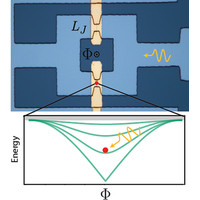Quasiparticle Dynamics in Epitaxial Al - InAs Planar Josephson Junctions
IF 11
Q1 PHYSICS, APPLIED
引用次数: 1
Abstract
Quasiparticle (QP) effects play a significant role in the coherence and fidelity of superconducting quantum circuits. The Andreev bound states of high-transparency Josephson junctions can act as low-energy traps for QPs, providing a mechanism for studying the dynamics and properties of both the QPs and the junction. Using locally injected and thermal QPs, we study QP loss and QP poisoning in epitaxial Al-InAs Josephson junctions incorporated in a superconducting quantum interference device (SQUID) galvanically shorting a superconducting resonator to ground. We observe changes in the resonance line shape and frequency shifts consistent with QP trapping into and clearing out of the ABSs of the junctions when the junctions are phase biased. By monitoring the QP trapping and clearing mechanisms in time, we find a time scale of O(1μs) for these QP dynamics, consistent with the presence of phonon-mediated QP-QP interactions. Our measurements suggest that electron-phonon interactions play a significant role in the relaxation mechanisms of our system, while electron-photon interactions and electron-phonon interactions govern the clearing mechanisms. Our results highlight the QP-induced dissipation and complex QP dynamics in superconducting quantum circuits fabricated on superconductor-semiconductor heterostructures.5 MoreReceived 16 March 2023Accepted 18 August 2023DOI:https://doi.org/10.1103/PRXQuantum.4.030339Published by the American Physical Society under the terms of the Creative Commons Attribution 4.0 International license. Further distribution of this work must maintain attribution to the author(s) and the published article's title, journal citation, and DOI.Published by the American Physical SocietyPhysics Subject Headings (PhySH)Research AreasMajorana bound statesQuasiparticles & collective excitationsPhysical SystemsSQUIDSemiconductorsSuperconducting devicesQuantum Information, Science & TechnologyCondensed Matter, Materials & Applied Physics

外延Al - InAs平面Josephson结的准粒子动力学
准粒子效应对超导量子电路的相干性和保真度起着重要的作用。高透明Josephson结的Andreev束缚态可以作为QPs的低能量陷阱,为研究QPs和结的动力学和性质提供了一种机制。利用局部注入和热QPs,研究了超导量子干涉器件(SQUID)中外延Al-InAs Josephson结的QP损耗和QP中毒。我们观察到当结相偏置时,谐振线形和频移的变化与QP进入和清除结的abs一致。通过实时监测QP捕获和清除机制,我们发现这些QP动力学的时间尺度为0 (1μs),与声子介导的QP-QP相互作用的存在一致。我们的测量表明,电子-声子相互作用在我们系统的弛豫机制中起着重要作用,而电子-光子相互作用和电子-声子相互作用支配着清除机制。我们的研究结果强调了在超导体半导体异质结构上制造的超导量子电路中QP诱导的耗散和复杂的QP动力学根据知识共享署名4.0国际许可协议,美国物理学会doi:https://doi.org/10.1103/PRXQuantum.4.030339Published。这项工作的进一步分发必须保持作者的归属和已发表文章的标题,期刊引用和DOI。发表于美国物理学会物理学科标题(PhySH)研究领域马约拉纳束缚态准粒子与集体激发物理系统squid半导体超导器件量子信息科学与技术凝聚态材料与应用物理
本文章由计算机程序翻译,如有差异,请以英文原文为准。
求助全文
约1分钟内获得全文
求助全文

 求助内容:
求助内容: 应助结果提醒方式:
应助结果提醒方式:


